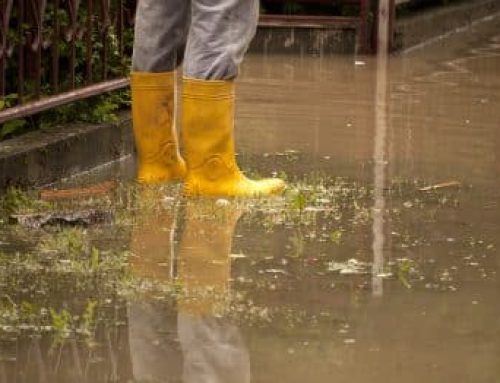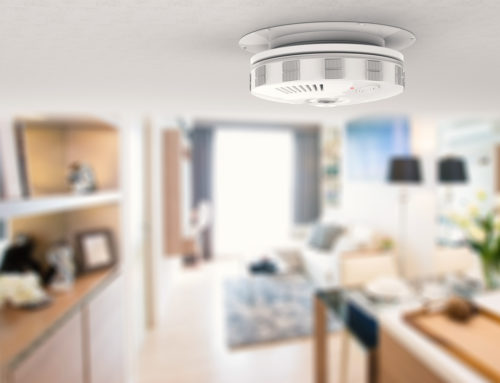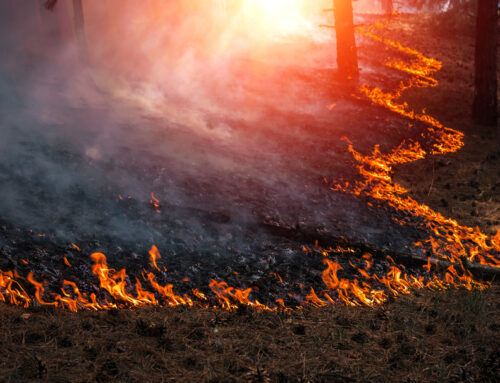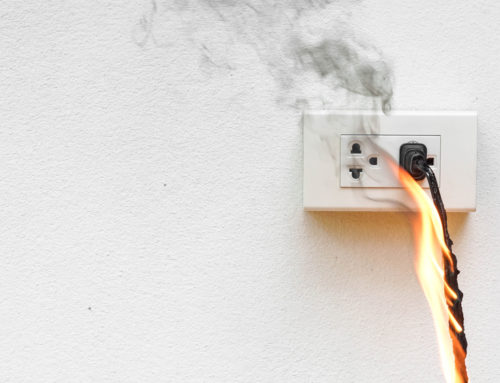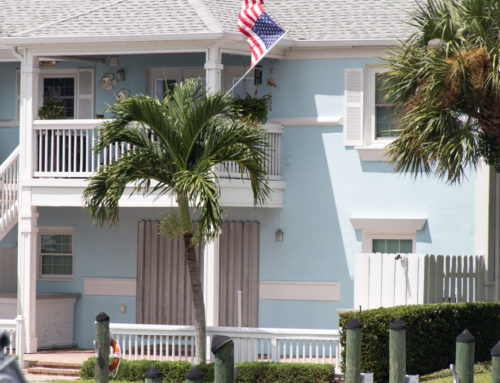The end of Daylight-Saving Time is coming, which means re-setting our clocks and “falling back.” (One more glorious hour of sleep!) As the daylight hours begin to wane, the types of risk your property faces also change. The quality of your preparation during milder transitional seasons like spring and fall will directly impact your property’s ability to handle the year’s most extreme weather conditions. Let’s talk about how your property’s risk changes in the fall and how you can fortify your investment for the more challenging months to come.
Here are 10 things that your house may experience and fall preparation tips:
1. Cold Pipes
Water damage from a burst pipe is one of the easier water losses to prevent. Unless your property experiences the freeze of the century, a few simple steps go a long way in helping you avoid this type of headache. To keep your property dry, insulate pipes near exterior walls. Tenants can help prevent a burst pipe during cold snaps by opening cabinet doors below the sink and keeping faucets on a slow drip to keep the water flowing.
For vacant properties, shut the water off at the street and drain the system. If you don’t and your heater is knocked out during a storm, you could end up with a watery mess to clean up! The cost of a copper theft can also be greatly amplified if the water is on when they remove parts of your plumbing system. Maintain the heat to at least 55 degrees Fahrenheit as the temperature inside the walls will be even colder. You may need to set your thermostat even higher for climates that experience extreme freezes.
2. More Cooks in the Kitchen
Many of us love spending time around the table with our families during the holiday season. Unfortunately, more cooks in the kitchen could mean more fires. Thanksgiving, Christmas Eve, and Christmas rank highest for cooking fires. How can you keep tenant chefs safe and save your investment from a costly fire?
- Maintain working smoke alarms. Working smoke alarms cut fire deaths in half, reports the National Fire Protection Association. Connected alarms are particularly effective as when one alarm sounds, all alarms sound, alerting the occupant(s) no matter what part of the house they are currently in.
- Fire extinguishers should also be placed throughout the home. These, however, must be maintained so they are ready for use – simply follow the manufacturer’s instructions. BC or ABC extinguishers can be a good choice as they put out a variety of types of fires. Tenants may need a crash course on how to use them properly too, so don’t make assumptions.
- Install a fire suppression device like StoveTop FireStop. This product is an inexpensive solution to reduce the damage caused by cooking fires. It may even put out a fire before the cook has time to grab a lid or standard extinguisher. When activated, extinguishing powder is released from the device onto the stove, while the “pop” of the can opening alerts the distracted cook to return to the kitchen to turn off the burners.
Pro Tip: Cooking should not be allowed in the garage, close to the house, or on decks, and Turkey Bombs (frozen turkeys put into hot grease) may be exciting but are extremely dangerous to those watching the show.
3. A Higher Usage of Electricity or Natural Gas
The cost of heating a home in the colder months can tempt some to choose more dangerous methods of staying warm in their home. Using an oven or space heater as an “alternative” heating source often results in a costly fire. How can you keep tenants from making this dangerous substitution?
First and foremost, make sure your heating system is in good working order and the house is properly insulated. Is it time for a furnace tune-up? Do windows need to be re-sealed? And, do doors need to be adjusted so they don’t let a draft through? If you stay on top of preventive maintenance, tenants may be less likely to think of using the stove or oven to heat the house.
Include language in your lease prohibiting the use of ovens as a heating source for the house and discuss the dangers with your tenants. The extended use of a gas oven can lead to carbon monoxide poisoning while keeping an electric oven on a high temperature for hours on end is both inefficient and dangerous.
If you allow space heaters, they should still not be used as the primary heating source in the house. Any space heater in use should be newer and equipped with safety features such as auto-shut-off if knocked over. Space heaters should never be used with an extension cord but plugged directly into the outlet. Lastly, keep a 3-foot safety zone around the heater; never leave heaters unattended or running overnight.
4. Piled up Logs in the Fireplace
If one of your property’s amenities is a fireplace, make sure it’s safe to use each year! Have your fireplace and chimney professionally inspected before use each fall. Install a spark-arresting screen or glass doors to prevent embers from catching rugs, drapes, or furniture on fire. Tenants should also keep a radius of 3 feet around the fireplace clear of any items that can burn.
5. Lint Build-Up in the Dryer Lint Trap & Exhaust Vents
Colder weather means bulkier clothing to wash and dry, causing lint to build up more quickly on the lint screen and in the dryer exhaust vent. Though your tenants should clean out the lint trap between each load of laundry, it’s your responsibility to maintain the exhaust vent. These should be cleaned at least once a year but should definitely be on your checklist for routine inspections. Keeping the lint screen and exhaust vent clean will keep the dryer from overheating and burning up your tenant’s clothing and potentially, your entire investment.
6. Smoke Breaks Inside the House
Whether you decide to allow smoking on the premises is up to you, but just be aware that cooler weather can drive smokers indoors for their smoke break. Whatever your policy, be sure to spell it out clearly in your lease and enforce it through routine inspections.
For rehabs, you will also need policies for smoking as contractors may decide to smoke in “unfinished areas” thinking it won’t affect their final product. However, cigarette smoke can easily saturate carpets and unfinished sheetrock. Sawdust is the perfect kindling for a fire and can go up in flames quickly. Smoking shouldn’t be allowed inside your rehab and be sure to hold your GC accountable for keeping a clean and safe job site.
7. More Visitors (Some welcome, some not-so-welcome)
We are headed toward the holidays faster than a speeding bullet, which means more visitors may be coming and going from your property soon. Remind tenants (and include in the lease) your policies regarding guests:
- Where guests should park.
- Instructions for out-of-town guests’ length of stay and when they will need to notify you about long-term guests.
- Confirmation of who is responsible for any damage a guest does to the property or any injuries a guest may sustain while your tenant is hosting them. (An important reason to require renters’ insurance!)
- Who is responsible for clearing walks and driveways during inclement weather. (You will need to make sure walkways and driveways are free of trip hazards like uneven pavement and that guardrails are secure.)
For vacant properties, keeping those who don’t belong there, out, will help you prevent many types of disasters from a fire, to water damage, to spray paint on the walls. Boarding up properties that aren’t being actively rehabbed or on the market for sale is a must. Beyond that, keeping the property tidy to onlookers (yard kept up, no junk mail cascading from the mailbox) will help deliver a message that someone may come to check on it at any minute. Use neighbors as a second set of eyes when you can’t be around. Layering your security system with proper lighting, door, and window reinforcements and an alarm is crucial too. The simple message: make your property look as lived-in as possible, check on it frequently and make it challenging for a would-be thief to break in.
8. Slippery Sidewalks and Driveways
One of the most common liability claims we see are from slip-and-fall injuries. These can result in anything from a broken toe to paralysis. To avoid becoming the defendant in a lawsuit:
- Repair any uneven pavement surrounding the house: sidewalks, pavers, and driveways.
- Make sure all guardrails and handrails are in place and secure. Guards are generally required for ramps, stairs, or landings above 30 inches, but someone can be injured quite severely when falling from a lesser height, so err on the side of caution and always follow any local codes.
- Specify in your lease who is responsible for clearing walks in inclement weather. Make sure your tenant is aware of what is expected of them and the dangers of neglecting this simple task.
9. Weather-Beaten Roofs and Siding
Before more severe weather arrives, be sure your property can handle it. Fall thunderstorms, excess snow, and ice dams can all spell big trouble for your foundation, cause water damage to the interior, or even a full roof collapse. To fortify the exterior:
- Replace missing shingles, repair nail pops, and seal around roof vents.
- Fight ice dams by correctly insulating your attic: seal any leaks, install correctly-rated insulation, and properly vent your roof.
- Remove excess snow before it can cause a roof collapse. Newer, pitched roofs are usually able to handle more snow than older roofs or those with minimal pitch. Wetter snow is also heavier; even a foot of snow may be too heavy of a load, so err on the side of caution.
- Seal up any cracks in the foundation, space around vents, gaps under doors or near windows, and holes for electrical, plumbing, and other utility lines. This will help with heating efficiency as well as keep any pests from entering the property.
- Don’t forget the paint! Keeping up on this simple task can prevent you from having to spend money on additional repairs – like wood rot!
10. Gutters Full of Leaves
If you are in a state where the leaves turn a variety of beautiful shades, the pretty colors can bring an extensive amount of cleanup. Leaves stacking up in your gutters can lead to drainage issues for your foundation and even water damage inside the house. A thorough gutter cleaning is necessary several times a year, but a cursory check can easily be performed during regular inspections.
The first step in preventing any damage or injury to your property is educating yourself about potential hazards. The next step is to take action! In that spirit, please take advantage of our free seasonal maintenance checklists:
After reading today’s article, you should have a good start for your fall preparation list and be on your way to ending the last quarter strong!


